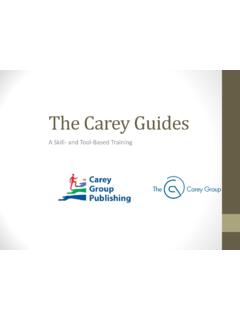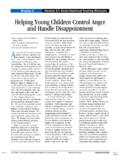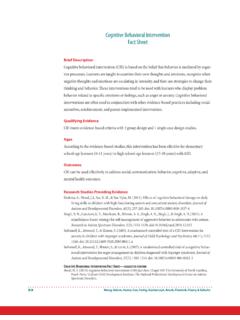Transcription of Cognitive Behavioral Interventions for Substance …
1 Cognitive Behavioral Interventions for Substance Abuse Overview Presentation TASC Conference 2013 University of Cincinnati Corrections Institute Curriculum Content, Format and Supporting Research Curriculum Organization Introduction and Preparation Material Pretreatment Modules (optional) Modules 1-6 Participant Worksheets Mod 1 (5) Motivation & Engagement Mod 2 (4) Cognitive Restructuring Mod 3 (8) Emotion Regulation Mod 4 (11) Social Skills Mod 5 (4) Problem Solving Mod 6 (7) Relapse Prevention Optional: Pre-Treatment Mod (3) Group Structure Ideal size: 8-10 (Max:16 = 2 facilitators) Group time: hours Modified closed group: entry points with pre-requisites, pages 11-13 Preparation requirement: ~30 minutes Homework: a key to transfer of practice Session Format Session background Facilitator notes Session materials Practice work review Group discussion and activities Practice work assignment Who May Deliver CBI-SA?
2 Individuals who have successfully completed CBI-SA training Preference to Substance abuse professionals State regulations may prohibit those without certification or licensure Who Would Benefit from CBI-SA? Clients who score MODERATE or HIGH need in the Substance use domain Admission does not require a Substance use disorder diagnosis Those with Substance abuse or dependence diagnosis are appropriate How is the term Substance Abuse used in the Curriculum? Substance abuse leads to impairment in some aspect of functioning Individual may or may not be dependent on substances Current Substance use (unless in a controlled environment) Is Abstinence Required? Abstinence is not required programs will use their own policies Safety could warrant banning participants currently under the influence Drug testing is often used to monitor.
3 But positive results are evidence of the need for treatment Drugs Work in Two Ways Mimicking the Neurochemical Processes Increasing Action of Endogenous Transmitters How it Works Dopamine affects pleasure center of brain Stimulates the release of dopamine at a rapid rate Experience of pleasure Over time results in dopamine depletion Reward Pathway Survival Craving The brain becomes active when a person with addiction sees or hears stimuli that trigger craving Individuals who suffer from addiction can learn how to manage cravings Craving Cocaine Rush, High and Craving Peaks 3 Minutes 11 Minutes 12th Minute Rush High Cognitive - Behavioral Interventions for Substance Abuse Motivational Engagement Cognitive - Behavioral Social Learning Emotion Regulation, Social Skills, Problem Solving Relapse Prevention We Poured Elements of Effective Intervention into the Curriculum Stages of Change Precontemplation C R I S I S Contemplation Determination Action Maintenance Relapse Stages of Change Project MATCH CBT MET 12 Step Facilitation Research on 12 Step Programs 2 Controlled Studies Mandatory AA with Offenders No Beneficial Outcomes Self-Help and Support Network Self-Help compliments and extends treatment effects Examples include 12 Step, SMART Recovery.
4 Women for Sobriety Support is key type of support can vary (church, family/friends, community groups) MI + CBT compared to CBT alone for Cocaine TX Attended more sessions Reported greater desire for abstinence Reported expectation of success Expected greater difficulty in maintaining abstinence No differences on cocaine use McKee, et al., (2007) Cognitive - Behavioral Treatment (CBT) Trigger Use THOUGHTS FEELINGS BEHAVIORS Cognitive - Behavioral Treatment (CBT) Trigger Refuse THOUGHTS FEELINGS BEHAVIORS Reinforcement Pavlov Video SA is Reinforcing Positive Reinforcement Social Situation + Substance Use Pleasure Negative Reinforcement Stressful Situation + Substance Use Reduced Unpleasant Feeling Charlie Brown and Lucy Motivational Incentives Marijuana Abstinence Post-Treatment Use of Lower Cost Items Petry (2000) has shown lower but still significant benefits from low cost incentives Use of fishbowl, refund of fees, etc.
5 Socio-economic status did not change efficacy of incentives Contact Information University of Cincinnati-UCCI Kelly Pitocco















